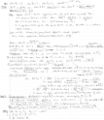12-240/Classnotes for Tuesday September 18: Difference between revisions
| Line 87: | Line 87: | ||
In any factorization of m, one of the factors is m and the other is 1. So m is prime. ∎ |
In any factorization of m, one of the factors is m and the other is 1. So m is prime. ∎ |
||
== Complex number== |
== Complex number== |
||
'''Abstraction, generalization, definition, examples, properties, dream, implications, realization = formalization, PROOF.''' |
|||
In '''R''', ∄ x s.t. x^2 = -1 |
|||
Dream: Add new number element 𝒊 to '''R''', so as to still get a field & 𝒊^2 = -1 |
|||
Implications: By adding 𝒊, we must add 7𝒊, and 2+7𝒊, 3+4𝒊, (2+7𝒊)∙(3+4𝒊), (2+7𝒊)^-1, etc. |
|||
So, how do we define this field? |
|||
'''C''' = {(a,b): a,b ∈ '''R'''} |
|||
Also, 0 (of the field) = (0,0); 1 = (1,0) |
|||
Define +: (a,b)+(c,d) = (a+c, b+d) |
|||
Define ∙: (a,b)∙(c,d) = (ad-bd, ad+bc) |
|||
'''Thrm. 1.''' ('''C''', 0, 1, +, ∙) is a field. |
|||
'''Thrm. 2.''' ∃ 𝒊 ∈ '''C''' s.t. 𝒊^2 = -1 |
|||
'''Thrm. 3.''' '''C''' contains '''R''' |
|||
Proof (1): Show that each of the field axioms hold for '''C'''. |
|||
== Lecture 3, scanned notes upload by [[User:Starash|Starash]] == |
== Lecture 3, scanned notes upload by [[User:Starash|Starash]] == |
||
Revision as of 22:36, 18 September 2012
| |||||||||||||||||||||||||||||||||||||||||||||||||||||||||
Various properties of fields
Thrm 1: In a field F: 1. a+b = c+b ⇒ a=c
2. b≠0, a∙b=c∙b ⇒ a=c
3. 0 is unique.
4. 1 is unique.
5. -a is unique.
6. a^-1 is unique (a≠0)
7. -(-a)=a
8. (a^-1)^-1 =a
9. a∙0=0 **Surprisingly difficult, required distributivity.
10. ∄ 0^-1, aka, ∄ b∈F s.t 0∙b=1
11. (-a)∙(-b)=a∙b
12. a∙b=0 iff a=0 or b=0
. . .
16. (a+b)∙(a-b)= a^2 - b^2 [Define a^2 = a∙a] Hint: Use distributive law
Thrm 2: Given a field F, there exists a map Ɩ: Z → F with the properties (∀ m,n ∈ Z):
1) Ɩ(0) =0, Ɩ(1)=1
2) Ɩ(m+n) = Ɩ(m) +Ɩ(n)
3) Ɩ(mn) = Ɩ(m)∙Ɩ(n)
Furthermore, Ɩ is unique.
Rough proof:
Test somes cases:
Ɩ(2) = Ɩ(1+1) = Ɩ(1) + Ɩ(1) = 1 + 1 ≠ 2
Ɩ(3) = Ɩ(2 +1)= Ɩ(2) + Ɩ(1) = 1+ 1+ 1 ≠ 3
. . .
Ɩ(n) = 1 + ... + 1 (n times)
Ɩ(-3) = ?
Ɩ(-3 + 3) = Ɩ(-3) + Ɩ(3) ⇒ Ɩ(-3) = -Ɩ(3) = -(1+1+1)
What about uniqueness? Simply put, we had not choice in the definition of Ɩ. All followed from the given properties.
At this point, we will be lazy and simply denote Ɩ(3) = 3_f [3 with subscript f]
∃ m≠0, m ∈ N, Ɩ(m) =0
In which case, there is a smallest m<0, for which Ɩ(m)=0. 'm' is the characteristic of F. Denoted char(F). Examples: char(F_2)=2, char(F_3)=3... but NOTE: char(R)=0
Thrm: If F is a field and char(F) >0, then char(F) is a prime number.
Proof: Suppoer char(F) =m, m>0. Suppose also m is not prime: m=ts, t,s ∈ N.
Then, Ɩ(m) = 0 = Ɩ(t)∙Ɩ(s) ⇒ Ɩ(t)=0 or Ɩ(s)=0 by P12.
If Ɩ(t)=0 ⇒ t≧m ⇒ m=t, s=1 or likewise for Ɩ(s)=0, and m=s, t=1
In any factorization of m, one of the factors is m and the other is 1. So m is prime. ∎
Complex number
Abstraction, generalization, definition, examples, properties, dream, implications, realization = formalization, PROOF.
In R, ∄ x s.t. x^2 = -1
Dream: Add new number element 𝒊 to R, so as to still get a field & 𝒊^2 = -1
Implications: By adding 𝒊, we must add 7𝒊, and 2+7𝒊, 3+4𝒊, (2+7𝒊)∙(3+4𝒊), (2+7𝒊)^-1, etc.
So, how do we define this field?
C = {(a,b): a,b ∈ R} Also, 0 (of the field) = (0,0); 1 = (1,0) Define +: (a,b)+(c,d) = (a+c, b+d) Define ∙: (a,b)∙(c,d) = (ad-bd, ad+bc)
Thrm. 1. (C, 0, 1, +, ∙) is a field.
Thrm. 2. ∃ 𝒊 ∈ C s.t. 𝒊^2 = -1
Thrm. 3. C contains R
Proof (1): Show that each of the field axioms hold for C.




